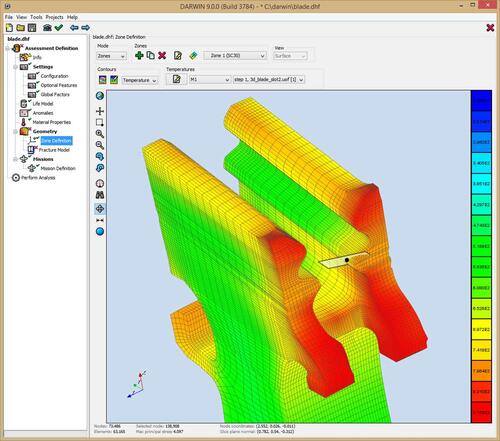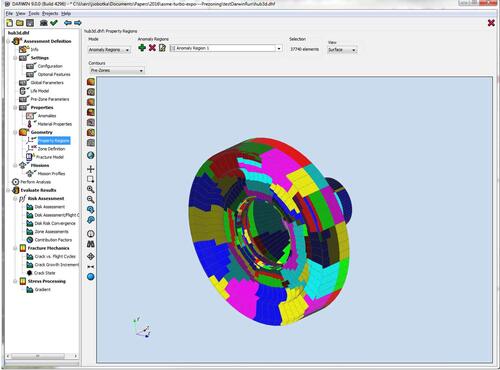DARWIN® supports advanced simulations of crack growth and fracture in metallic components subjected to cyclic stress and temperature histories. The following applications are supported:
- Life and risk estimates for components with inherent anomalies – Metallic components may have internal anomalies that can act as crack pre-cursors. These anomalies are often randomly distributed throughout the geometry and can lead to fracture. DARWIN enables users to quantify the fracture risk by simulating crack growth histories with uncertainties in initial crack sizes, input stresses, material properties, and inspection parameters.
- Life and risk estimates for components with surface damage – Manufacturing and maintenance processes can introduce damage on surfaces that can lead to growing fatigue cracks. Fatigue processes increase crack size. DARWIN provides users with advanced techniques to determine the service life of components with a known initial crack size or the fracture risk of components with uncertainties in initial crack sizes and other input parameters.
- Stress processing – Finite element stresses imported into DARWIN may be further interrogated and modified using innovative tools available through the graphical user interface. Available methods summarize the loading history, highlight critical load steps, and superimpose local or global residual stress gradients. The effects of local plasticity on stress gradients can be estimated using shakedown methods. Multiple load steps can be paired into stress cycles using rainflow algorithms.
- Part certification – DARWIN enables its users to satisfy corporate requirements and government regulations (e.g., FAA Advisory Circulars) for damage tolerance of life limited parts in gas turbine engines. Corrective actions such as NDE inspections and component replacement can be used to reduce fracture risk.
- Hotspot detection – Risk limiting regions may occur in non-intuitive locations due to combinations of geometry, stress, temperature, and material property factors. DARWIN computes life contours and risk contours throughout components to detect critical regions for crack growth and fracture.
- FRANC3D interface for non-parametric crack shapes – The extensive library of crack solutions in DARWIN can be expanded by generating tables of stress intensity factors (K) for arbitrary three-dimensional cracks using the FRANC3D interface. FRANC3D inserts cracks into the original component finite element model. Further analysis determines the evolving shape of the crack and the corresponding K values around the crack front. DARWIN imports and uses these solutions to determine life and risk values for components.
- DEFORM interface for computer-aided manufacturing – Simulations of manufacturing processes can provide estimates of location-specific residual stresses, material microstructure (e.g., grain size), and anomaly distributions. DARWIN has partnered with DEFORM to support fracture life estimates that incorporate the influence of the manufacturing process, including the impact of variability or uncertainty in that process.
- External user modules – DARWIN provides advanced programming interfaces (API) functions to users who can supply their own modules for crack formation, crack propagation, and material property scaling.



